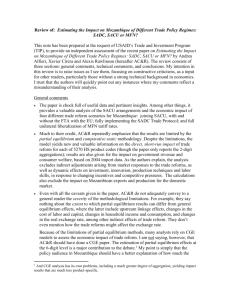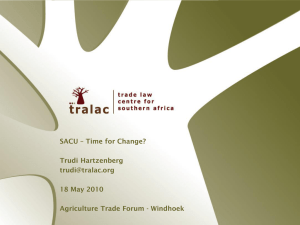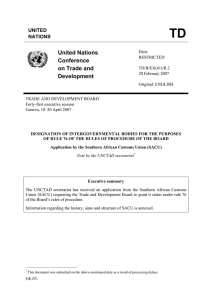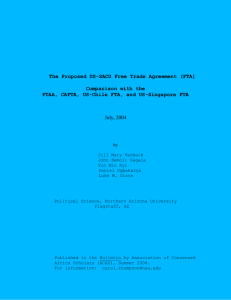Review of Estimating the Impact on Mozambique of Different Trade
advertisement
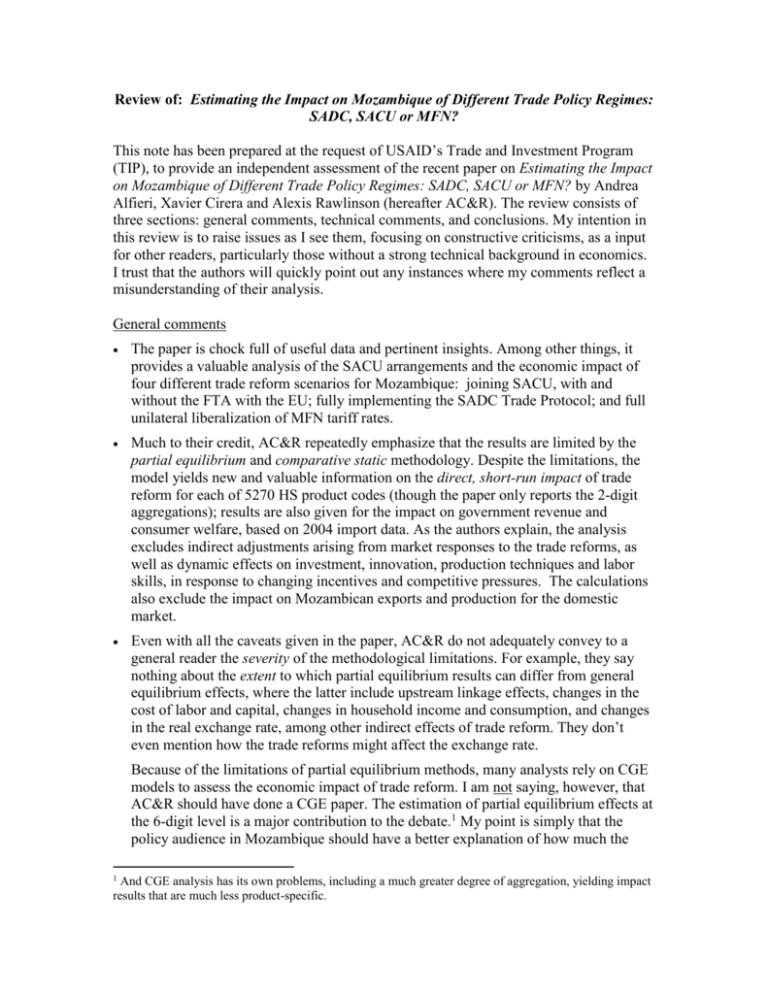
Review of: Estimating the Impact on Mozambique of Different Trade Policy Regimes: SADC, SACU or MFN? This note has been prepared at the request of USAID’s Trade and Investment Program (TIP), to provide an independent assessment of the recent paper on Estimating the Impact on Mozambique of Different Trade Policy Regimes: SADC, SACU or MFN? by Andrea Alfieri, Xavier Cirera and Alexis Rawlinson (hereafter AC&R). The review consists of three sections: general comments, technical comments, and conclusions. My intention in this review is to raise issues as I see them, focusing on constructive criticisms, as a input for other readers, particularly those without a strong technical background in economics. I trust that the authors will quickly point out any instances where my comments reflect a misunderstanding of their analysis. General comments The paper is chock full of useful data and pertinent insights. Among other things, it provides a valuable analysis of the SACU arrangements and the economic impact of four different trade reform scenarios for Mozambique: joining SACU, with and without the FTA with the EU; fully implementing the SADC Trade Protocol; and full unilateral liberalization of MFN tariff rates. Much to their credit, AC&R repeatedly emphasize that the results are limited by the partial equilibrium and comparative static methodology. Despite the limitations, the model yields new and valuable information on the direct, short-run impact of trade reform for each of 5270 HS product codes (though the paper only reports the 2-digit aggregations); results are also given for the impact on government revenue and consumer welfare, based on 2004 import data. As the authors explain, the analysis excludes indirect adjustments arising from market responses to the trade reforms, as well as dynamic effects on investment, innovation, production techniques and labor skills, in response to changing incentives and competitive pressures. The calculations also exclude the impact on Mozambican exports and production for the domestic market. Even with all the caveats given in the paper, AC&R do not adequately convey to a general reader the severity of the methodological limitations. For example, they say nothing about the extent to which partial equilibrium results can differ from general equilibrium effects, where the latter include upstream linkage effects, changes in the cost of labor and capital, changes in household income and consumption, and changes in the real exchange rate, among other indirect effects of trade reform. They don’t even mention how the trade reforms might affect the exchange rate. Because of the limitations of partial equilibrium methods, many analysts rely on CGE models to assess the economic impact of trade reform. I am not saying, however, that AC&R should have done a CGE paper. The estimation of partial equilibrium effects at the 6-digit level is a major contribution to the debate.1 My point is simply that the policy audience in Mozambique should have a better explanation of how much the 1 And CGE analysis has its own problems, including a much greater degree of aggregation, yielding impact results that are much less product-specific. limitations may matter. For generalist readers, it’s not enough to cite the caveats. Moreover, ACR claim that the partial equilibrium analysis provides “a clear orientation of the sign and magnitude of the changes expected…” (end of section 3.1, with similar language in section 9.1). This may be seriously misleading. The same comment applies to the static nature of the methodology, perhaps more strongly. AC&R do explain very clearly that the results exclude dynamic effects. But here, too, they do not adequately convey the severity of the problem. Indeed, the prospective dynamic gains are the driving force behind efforts to liberalize trade, across the globe. Estimates of the static effects routinely reveal very small net changes in welfare from trade reform. Some other important issues are more technical in nature. See next section. Technical comments, in order of appearance. Asterisks (***) indicate importance.2 Intro, para 5 - impact on exports: AC&R suggest that not having estimates of the impact on exports does not matter much because Moz already benefits from duty-free access for most products to RSA and the EU. Later, they also (rightly) express doubt that exports would rise significantly due to cost and capacity constraints. Nowhere do they point out, however, that import taxes have adverse general equilibrium effects on exports equivalent to a tax on the latter, through adjustments in the exchange rate and incentives for resources to move away from export industries. * After Table 2 – the higher duty rates are mainly for revenue collection: It’s almost tautologically true that goods facing higher duty rates are the main source of customs revenue. But the revenue objective could just as well be achieved with lower and more uniform rates. Thus, revenue objectives cannot explain for the observed dispersion in duty rates, which create very high rates of effective protection and costly incentives for inefficient resource allocation. * Section 3.1 - price elasticities: The analysis would be improved by (a) more justification for using unitary export elasticity for RSA, rather than a higher or lower elasticity, and (b) sensitivity analysis reporting the effects of alternative parameterization. The reader is given no clue about the extent to which this assumption affects the results. ** Section 3-2 – Definition of scenarios: The MFN scenario is a curiosity. It’s not clear that this is a very informative option, because no one is advocating zero duties across the board. A better option would have been to examine the effects of moving to a low, uniform tariff at (say) 5% while eliminating all exemptions. *** Same place: I don’t see why the reduction to 20% in top duty rate is incorporated in the post-reform scenarios but not the baseline. Using 25% for the baseline overstates the revenue loss from the indicated reforms. Worse, Table 6 shows the 20% rate being used for only the FTA scenario. If other scenarios do not incorporate the top-rate reduction, then the revenue impacts are all skewed against FTA. 2 I avoid using page numbers for reference because some readers may be printing on A4 rather than lettersize paper, which affects the pagination. *** Below Table 6, SACU scenarios: It’s hard to see how Mozambique could avoid the de facto effect of the TDCA under SACU. Thus, the SACU 1 scenario (without TDCA) is largely irrelevant. There also seems to be a serious problem with the SACU 2 (with TDCA) scenario. The calculations include the effect of reducing duties on imports from the EU to zero, but exclude the impact of TDCA the price of imports from RSA. Consequently, it’s not clear that either SACU scenario makes sense. ** Figure 3: For generalist readers, it would be useful to use this figure to make a few additional pedagogical points: o In this case eliminating duties on SADC imports has no effect on the price or the consumer surplus in Moz. There is still a negative revenue effect, equal to the shaded area shown in my Figure 1 below. (This point is presently buried in the Methodological Appendix.) o In this case, the shaded area also represents a real resource cost to Mozambique from trade diversion. Moz will now be paying South African suppliers a price of (1+τ)p*. In the initial (tariff-ridden) situation, suppliers in RSA were only paid p*, with the difference being a transfer from consumers in Moz to the Treasury in Moz – not a real welfare cost to the nation. (More on that below). Figure 1: Imports from SADC and ROW SADC1 Price SADC0 E1 (1+τ)p* ROW1 E0 p* ROW0 Demand Imports Msadc1 Msadc2 M1 M0 *** Para after Eq (12) – Import demand elasticity assumptions: These parameters are critical to the empirical results, and should not be dished up with a simple reference to Stern et. al (1976). Please elaborate! Are the Stern estimates pertinent to a country like Mozambique? What are some representative parameter values for key sectors? Are these short-run or long-run elasticities? How sensitive are the results to reasonable parameter changes? Am I making a mountain out of a molehill? Section 4.1, first bullet (and section 4.4) – SACU w/o TDCA involves “greater protection than existed in 2004”: The numbers here don’t support this statement. They show that under SACU 1 the average price of imports drops by 3.55%, and (in Table 7) the value of imports falls less than this, indicating a rise in import volume. A drop in import prices and rise in volume do not suggest greater protection. **** Before Table 7 – revenue losses exceed consumer gains, implying overall national welfare loss: This is the first of many places in the paper where the algebraic sum of the change in revenue and the change in consumer surplus is used to tally the change in national welfare. Either I’m not thinking clearly (always possible!) or this computation introduces a major problem with the quantitative results. Let me use a simple example, shown in my Figure 2 (below), to make my point. The example is the MFN case, with a tariff of τ applied to all imports of a particular good. Figure 2: Simple tariff case Price E1 (1+τ)p* A ROW1 B E0 p* ROW0 Demand Imports M1 M0 Suppose we remove the tariff. Consumer surplus improves by A+B, while revenue declines by A. The foregone revenue, however, is a transfer from the Treasury to the consumers. It is not a national welfare loss. This is clearly explained in the JEL paper by Panagariya (2000, p. 290-291), which the present study cites as the main source of the model being used. Furthermore, in the MFN case, area A cannot possibly exceed area (A+B). The difference (triangle B) is often called the “deadweight loss,” because this part (and only this part) of the tax-induced loss to consumers is not offset by a corresponding gain to the Treasury. When the tax is removed, triangle B represents the net gain in national welfare, which must be positive in the partial equilibrium model. The case shown in my Figure 1, above, is quite different. There is no change in the equilibrium price or quantity, and therefore no change in consumer surplus. And in that example the loss of revenue does correspond to a national welfare loss – but the welfare effect derives from paying a higher price to suppliers in RSA, not from the loss of revenue to the Treasury. Thus, the change in national welfare is not equal to the change in revenue plus the change in consumer surplus. The correct formula is to tally the net welfare effect as the change in the deadweight loss triangle plus the change in the real cost of imports due to trade diversion. ** Section 5.2 – fraud adjustment: I haven’t read Van Dunem’s (2005) paper to see how he arrives at the fraud elasticity of 1.4. But the explanation given here suggests that Van Dunem assumes that the entire bilateral discrepancy between the reported CIF value of imports to Moz and exports from RSA is due to fraud on the Moz side. That sounds plausible. Except that (a) footnote 4 in section 2.1 suggests that the discrepancy is very small, which belies such a large elasticity; and (b) there is a history on the RSA side of claims for fictional exports or back-and forth exports for purposes of defrauding the government on duty drawbacks, VAT refunds, and other export incentives. Also, (c), it’s unlikely that a single elasticity applies to a reduction from 20% to 5% versus a reduction from 5% to 0%. This adjustment turns out to have a large effect on the results. Thus, it merits more careful discussion, and possibly more careful application of Van Dunem’s estimate. Several tables (e.g., Tables 22 and 28) lack mention of units. Are the numbers in rand, dollars, millions, billions? * Just below Table 24 – Kirk and Stern (2004) results: There is such a large difference between the present results and those of Kirk and Stern – even a reversal in the sign of the net welfare effect – that one would appreciate a more thorough discussion of the reasons. * Section 7.1 – price transmission: This excellent passage neglects an important point. The net welfare effect from trade liberalization should include the net benefit to consumers from lower prices on goods produced domestically that face more intense foreign competition due to the reform. To be sure, there is a corresponding loss of income to domestic producers, but as resources are reallocated to alternative uses, a simple partial equilibrium model shows that the benefit to consumers exceeds the loss to producers. Calculations in this paper show only the welfare change associated with net imports (because that’s where we have data). This focus is likely to understate the change in national welfare, possibly to the point of reversing some results. This is just another way of underscoring the limitation of the partial equilibrium analysis. * Section 8, trade deficit – The analysis in this section is weak. Changes in the overall trade balance are inherently driven by a variety of macroeconomic and microeconomic factors that fall well outside the scope of the partial equilibrium analysis in this paper. Among other things, the trade balance varies with the availability of international financial flows (including grants and remittances); the trade balance also depends heavily on the balance between domestic saving and investment; changes in trade patterns due to economic reforms may produce offsetting exchange rate effects. In addition, the rapidly growing trade deficit indicated in Table 28 is a figment of the dates chosen. Using 2002 as the starting point rather than 2001, the deficit has narrowed, not widened. In essence, this section reads like an afterthought and adds nothing useful to the findings. Methodological Appendix: I went through only a few sub-sections, and found a few issues of note: o Section 10.2.1.2 Case 2: As I understand this case, Trade Creation (TC) is not zero. This can be seen in the difference between M* and M0 in the graph, and the fact that both variables enter the CS equation. o Same section and case: the equation for ΔE seems to include only the quantity effect on VAT revenue and neglect the price impact from having a smaller tariff rate (=P0 - Psa in Figure 10.2.1) o *** Same section and case: This section has the first appearance of the equation for the net national Welfare Effect (WE) in the Appendix. It is given as: WE = ΔR + CS. In line with my earlier comments, and my Figure 2 above, CS is defined to include the revenue loss rectangle plus the deadweight loss triangle. If my comments are on target, then this is not the correct equation for WE. The problem applies throughout the paper. o *** Section 10.2.4, MFN scenario: The equation for CS in this section appears to be incorrect. Elimination of the tariff (τ) yields a gain in consumer surplus equal to ΔP*M0 (the rectangle) plus (1/2)*ΔP*ΔM (the triangle). Also, the labels for P and M in Figure 10.2.4 are incomplete. Conclusion The authors deserve great credit for producing these important results, and also for calling attention to shortcomings of the static partial equilibrium analysis used in the paper. Their computations provide very interesting and useful information on the direct impact of trade reform on particular sectors, but their overall conclusion should be much more attenuated. Despite the caveats, the authors lean too heavily on the empirical results to make the case for joining the SACU customs union. This is particularly problematic considering that the results for the SACU case are estimated using the current revenue sharing formulae. As the authors acknowledge, the consequent changes affecting the revenue shares for BLNS raise serious doubts that SACU would admit Mozambique using this formula. In addition, my technical comments raise several questions about the calculations, especially the net national welfare effect, and the sensitivity of the findings to variations in key parameter assumptions. After reading the paper, I conclude that moving ahead with discussions on joining SACU is warranted. But this conclusion is driven by impacts that are outside the static partial equilibrium model, such as unhindered trade with the dominant regional economy in South Africa, the likely impact on investment, and simpler rules of origin. The revenue effect is a possible bonus for entering SACU, but it should not be regarded as a motive. This is because the estimates are soft, and the revenue sharing arrangement is likely to change anyway if Mozambique were to be admitted. However, the potential negative effects of SACU membership must be kept clearly in mind. These include the loss of control over tariff and excise policies; accession to a more complex tariff structure; and exposure to trade policy decisions made by South Africa in response to domestic political pressures. The policy decision therefore involves judgments on the trade off between benefits and costs. The answer cannot be determined by technical analysis alone. -----------------Bruce Bolnick Nathan Associates October 25, 2006
